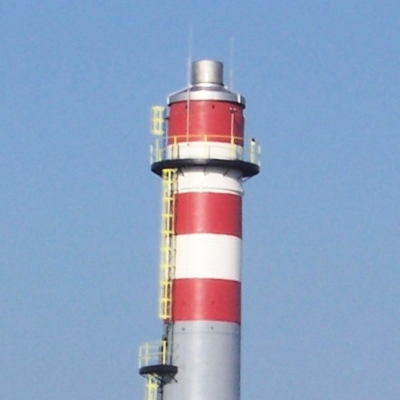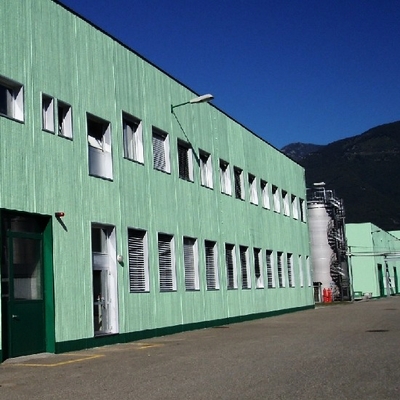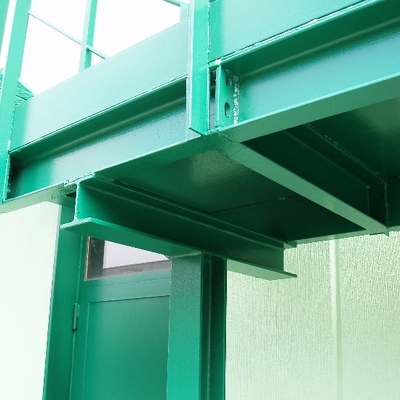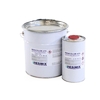RESICOLOR 475
BI-COMPONENT ACRYLIC-POLYURETHANE ENAMEL FOR INDOOR AND OUTDOOR APPLICATIONS
Two component, coloured acrylic polyurethane enamel, UV-resistant, protects against acid rain and protects concrete against carbonation. Recommended for painting reinforced concrete road works, plaster and walls exposed to driving rain, terrace walls, cornices, garage interiors, and as a protective finish on iron works.
RESICOLOR 475 forms thermosetting shiny film, with good mechanical resistance to wear and scratching.
The concrete and mortars are subject to continuous aggression due to polluted atmospheres (acid rain)
which penetrate the concrete and will quickly lower the pH by attacking the inside until rusting reinforcement
steel bars; RESICOLOR 475 applied as a topcoat over a primer as RESICOLOR 451 gives effective
protection, durable and aesthetically very valuable.
- Good resistance to acid and basic solutions diluted, acid rains, salt solutions used as antifreeze, fuels, oils and lubricants;
- excellent UV color stability and gloss and weather resistance which allows application indoor and outdoor;
- has a high covering power that allows paintings with low consumption;
- fast hardening: the product is painted over after a few hours after application;
- physical and mechanical characteristics that are stable over time;
- it can be washed with high pressure water jet, even with hot water or with detergents and degreasers concentrates thus allowing a better cleaning of the surface.
| U.M. | ||||||||||||||
|---|---|---|---|---|---|---|---|---|---|---|---|---|---|---|
| Appearance of the hardened film | 55 - 60 gloss | |||||||||||||
| Thickness of the hardened film for single layer | 40 - 80 | μm | ||||||||||||
| Adhesion to concrete (with RESICOLOR 451 primer) | > 4 | N/mm2 | ||||||||||||
| Adhesion to steel (*) | > 2 | N/mm2 | ||||||||||||
| Cross-hatch test: on steel on RESICOL 451 | ISO 0 ISO 1 | ASTM 5B ASTM 4B | ||||||||||||
| Solid content (mass) (volume) | 61 % 49 % | |||||||||||||
| Viscosity at 25°C (A+B) | 3200 - 4500 | cP | ||||||||||||
| Resistance to abrasion: Taber (500 g 17 weights concrete wheel, 500 cycles)) Taber (500 g 17 weights concrete wheel, 1000 cycles) | 20 50 | mg | ||||||||||||
| VOC: Reg. 2004/42/CE | Cat A/j - BS - 500 gl (2010) 370 gl | |||||||||||||
| Specific weight of the mixture | 1,27 | Kg/dm3 | ||||||||||||
| A + B mixture ratio | 100 + 20 |
(*) this value refers to product applied with RESICOLOR 425 primer.
Preparation of the support
The surface to be treated must be clean, healthy, dry, crumbly part and cement grout-free: best adhesion is achieved by hardening it with sand-blasting, sand-papering, acid washing, smoothing or shot-peening treatment. Remove any trace of dust and dirt using an aspirator.
Cement supports affected by rising damp must be treated with two coats of RESICOL 118 (vapour barrier).
Very porous concrete surfaces or surfaces with cracks and W (omega) cavities, e.g. forming concrete, must be levelled in advance with RESICOL 100, epoxy adhesive.
Application on metals requires accurate preparation of the support: elimination of oils, fats, varnishes and rust through abrasive process or white metal sanding (SA 2 – SA 3 degree).
Application of the primer or bottom coat
RESICOLOR 475 can be applied directly on concrete or metal.
To obtain a coating with higher performance (chemically aggressive environments or the need for frequent washing at high pressure and/or with hot water), apply a primer as RESICOLOR 451 on concrete surfaces or cement plaster; in anticorrosion cycles of metal surfaces, apply two coatings with primer RESICOLOR 425.
Preparation of the product
Pour component B into component A and blend at slow speed for 3’ – 5’ using drill with helix/spiral to reduce air inlet as much as possible; during this operation, carefully scrape also the bottom and the sides of the bucket.
Application
Apply with a brush, roller or airless spray (nozzle diameter 0.20 - 0.30 mm), in one or two coats, with an average consumption of 80 to 120 g/m².
The roller application on less absorbent surfaces can result in formation of microbubbles; it is advisable to slightly dilute the product (max. 5% of solvent RESISOLV 111) and apply several light layers; use rollers Mohair shorthair, specific polyurethane finishes.
Notes
For spray or brush the product is ready for use; in case of roller application, add the antibubble additive sold together with the product to reduce the risk of formation of bubbles and wrinkling of the surface that can occur with this type of processing.
Do not apply the product thick layers: a consumption higher than indicated can lead to the formation of
bubbles or cracks.
Do not apply with humidity above 60%, and when the ambient temperature exceeds 35 ° C or is below 10 ° C.
Do not work on rainy days and in the hours immediately after the rain; in particular for outdoor applications on concrete or plaster, make sure the surface is dry.
The presence of water has a negative influence on adhesion; substrates wet must be dried as much as
possible with compressed air.
Following mixture, the reaction between the two components takes place immediately. Processing time is
therefore limited and depends on temperature.
| Temperature | Pot life | Tack free | Paintable again after | |||||||||||
|---|---|---|---|---|---|---|---|---|---|---|---|---|---|---|
| 10 °C | 6 hours | 120-130 min | 12 hours | |||||||||||
| 20 °C | 4 hours | 70-80 min | 8 hours | |||||||||||
| 30 °C | 3 hours | 50-60 min | 6 hours |
The values were determined with thicknesses of about 80-100 microns.
It's not recommended application at temperatures below + 5 °C and above + 30 °C.
The complete hardening occurs after seven days at a temperature not lower than 20 °C.
To achieve hard and compact films, consumption ranges from 80 to maximum 120 g/m²·coat; higher
consumption results in a reduction of surface hardness.
6 Kg and 30 Kg A + B packages.
If stored in its original and sealed package, the products remains unaltered for a year if kept in a closed and protected environment with a temperature between 10 and 30 °C.
Execution of waterproof protective coatings of concrete, cast on site or prefabricated, surfaces smoothed with cement plaster for indoor and outdoor applications, subject to the exposure of the elements and iron/steel structures as topcoat in anti-corrosion cycles.
Indoor use
- garages, basements, utility rooms (elevator, boiler room) to improve the appearance and make it easy to clean the surface;
- warehouses and garages for easy cleaning;
- workplaces with presence of acids and bases.
Outdoor use
- protective coating of concrete structures of bridges, viaducts and road works, subject to weathering;
- very resistant finishing of iron/steel handworks: bridges, railings, walkways, shelters, containers, machinery and industrial equipment;
- painting of interior walls plastered or treated with skimming mortars, to make surfaces washable;
- painting of outdoor concrete tanks and sewage treatment plants in the chemical and pharmaceutical industry, with good resistance to acid and basic solutions at low concentration;
- Sport: topcoat wear of concrete bleachers;
- painting of casted or prefabricated concrete cornices and balconies.







